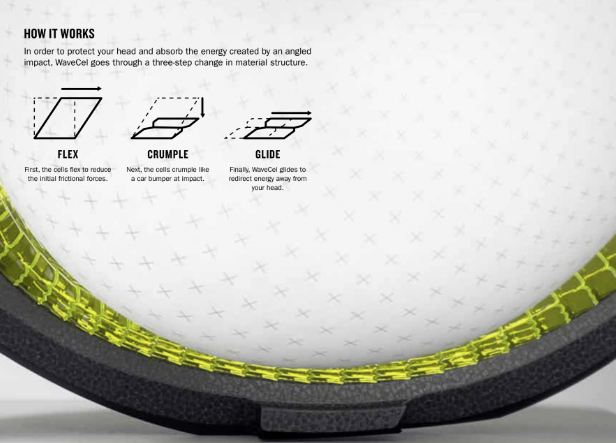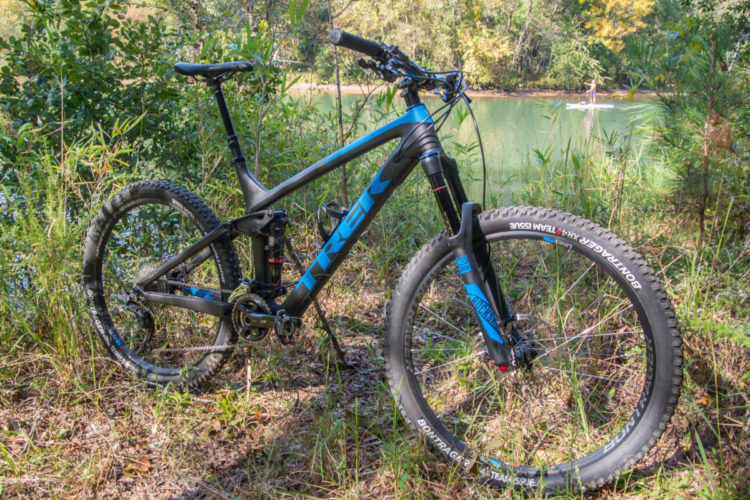
Two weeks ago, Trek and Bontrager revealed what they called “the biggest helmet and bike safety news of the year (and in decades).”
Trek claims that WaveCel is 48 times more effective than standard helmets at preventing concussions from common bike accidents by reacting to impact in three phases – flex, crumple, and glide, which are said to disperse the energy from an impact. Unlike a standard foam helmet, the WaveCel better reacts to twists, turns, and angled impacts, according to Trek.

WaveCel is a collapsible material made of cells, developed by orthopedic surgeon Dr. Steve Madey and biomechanical engineer Dr. Michael Bottlang. WaveCel supposedly moves more independently in a crash and the cells flex, and then crumple to reduce linear acceleration, and then glide to reduce rotational acceleration. Trek says that 99 times out of 100, WaveCel prevents concussions from “common accidents*,” though it should be noted there’s an asterisk at the end of their statement.
The asterisk further defines that these results are based on AIS (abbreviated injury score) 2 Injury (BriC) at 6.2 m/s test at 45° comparing a standard foam EPS Helmet and the same helmet modified with WaveCel insert as described in detail in Comparison of Bicycle Helmet Technologies in Realistic Oblique Impacts.
The study compared the WaveCel helmets with standard EPS foam helmets and MIPS helmets.
“Results of this study are limited to a narrow range of impact conditions, but demonstrated the potential that rotational acceleration and the associated brain injury risk can be significantly reduced by the cellular WAVECEL concept or a MIPS slip liner.” Yep, or a MIPS liner. Overall, they tested 20 control helmets (foam EPS), 20 Slip (MIPS) helmets, and 20 modified Scott helmets with a 15mm thick WaveCel structure placed inside of them, after some of the foam EPS was bored out.
The study
The results in the study were clear. Foam EPS helmets do a great job at preventing skull fractures, but are not optimized to reduce rotational head acceleration in impacts. It goes on to say that both MIPS and WaveCel showed that they can both be effective in reducing rotational acceleration. The study was based on four criteria and states that since industry testing doesn’t measure rotational impacts, and most bicycle crashes result in an oblique, angled impact, their intent was to also measure the efficacy of different helmet technologies after oblique impact tests.

Linear acceleration
MIPS helmets didn’t reduce linear acceleration compared to EPS foam helmets in any impact scenario, according to the study. The WaveCel helmet “significantly reduced” linear acceleration compared to EPS foam with reductions ranging from 16% to 26%, depending on the test method.
Rotational acceleration
According to the study, MIPS helmets significantly reduced rotational acceleration compared to EPS foam in all impact scenarios, ranging from 21% to 44%. WaveCel helmets reduced damage by 34-73%, compared to the EPS foam helmet.
Rotational velocity
In these results, MIPS helmets reduced rotational velocity compared to EPS foam helmets in all scenarios by 15-67%, depending on the test. The WaveCel helmets reduced velocity by 50-84%.
Brain injury risk prediction
MIPS helmets reduced the probability of sustaining a AIS 2 brain injury in all scenarios, compared to EPS foam helmets by 32-91%, depending on the test. WaveCel helmets were said to reduce brain injury in all scenarios compared to traditional helmets also, between 81-98%, depending on the test.

Then, there are some disclosures near the end of the study.
“Some of the authors (MB, SMM) are co-inventors of CELL technology described in this manuscript, have filed patents, and have a financial interest in the company that owns this technology.” It elaborates, saying “None of the authors received any money or inkind contribution for this work.”
The prices aren’t cheap for the WaveCel helmets. For a basic commuter or road helmet, they start at $150. For a better road bike helmet and the mountain bike helmet, they cost $300. But Trek backs the helmet with a 30-day guarantee and will replace the helmet if a buyer crashes with it in the first year.
Trek has had a huge launch with thorough media coverage, sponsored content, and advertisements on the new product. It didn’t take long for other folks in the helmet business to respond.
Competitor responses

MIPS quickly responded to Bontrager’s claims and the findings in the study.
“WaveCel has made sizeable claims about the efficacy of this technology,” said MIPS in a press release. “Preliminary test results of WaveCel helmets by MIPS cannot substantiate these claims. While further testing is warranted, MIPS cannot see that the helmets perform in a way that the claims Bontrager/WaveCel makes in the comparison between WaveCel and other helmets/technologies.”
MIPS plans to test WaveCel further and publish its findings.
Koroyd followed with another rebuttal and didn’t mince words.

“Last week Bontrager launched a new helmet material that claims to be the panacea of head protection. Dressed in the same translucent green colour Koroyd became famous for and marketed under the trademark WaveCel, this open-cell material is claimed to decrease acceleration from linear impacts and reduce the rotational forces on the brain under oblique impacts. One journalist has even dubbed this new “holy-grail” technology as ‘Koroyd 2.0’ which would be a fitting title – IF you chose to believe the hype.”
Why doesn’t Koroyd buy it? Well, because according to Koroyd, their material is the most efficient at absorbing impacts from energy, which is of course backed by another study.
Koroyd also says that linear deceleration is of the utmost importance, even though reducing rotational forces has taken the helmet market by storm in the past few years.
“It should be noted that this subject still remains unaddressed by the international standards surrounding head protection,” says Koroyd in a press release. “Whilst not currently a legal requirement of any helmet, rotational impacts are known to represent a risk – and one which is actually substantially reduced as a by-product of reducing LINEAR ACCELERATION.”
And to refer to the WaveCel study again, they chose angled impacts to test because they’re most similar to real world crashes, they say. “Moreover, these injury risk curves are highly non-linear, for which reason a relatively small difference in peak rotational velocity can translate into a large difference in injury probability.” Wow, it’s confusing to be a consumer sometimes.
It’s clear that in their press release, Koroyd’s interests are in promoting what it does best, and that is reducing linear acceleration. Since linear acceleration is a standard in international testing, Koroyd reminds everyone in the press release that their material “dramatically” outperforms the competition in linear acceleration tests.
“Regardless of the impact direction, ultimately linear acceleration is always going to be important. And reducing linear acceleration will also reduce angular acceleration which is a result of oblique impacts,” says Priya Prassad, a PhD and expert in biomechanics.
Koroyd says that they welcome new helmet technology which may reduce injury, but remain wary of what WaveCel says it does and that it’s potentially harmful to shift the conversation away from recognized industry standards, i.e., focusing again on rotational forces rather than linear impact and acceleration.

Even so, Koroyd contradicts itself in at least one manner, by saying that it’s not as important to focus on rotational force reduction as linear deceleration, because rotational force reduction isn’t an industry standard. Meanwhile, Koroyd believed that the risk of acceptable injury in industry standards was too low, which led them to develop Koroyd, so maybe all of the standards come up a little short? In that case, the bottom line is that new research and development in helmet technology isn’t a bad thing, no matter how you dice it.
Reading research and responses by all three helmet manufacturers — WaveCel, MIPS, and Koroyd — it seems like the best helmet is one that combines rotational force protection and linear acceleration reduction. A WaveCel helmet claims to do this, and so would a helmet like the Smith Forefront which has Koroyd and MIPS.
It makes sense that all of these helmet systems are going to say that their technology is the most important, and that their claims are backed by science. The business of proper protective equipment is a business after all.





















8 Comments
Apr 8, 2019
Apr 15, 2019
Apr 12, 2019
They have a very extensive database of bike helmets that it kept current. It's definitely helpful when comparing helmets, though the sheer number of options can be overwhelming.
It seems that the real problem with assessing helmets is that while there are established standards for impact protection, there are currently no standards for testing rotational protection. Helmets.org talks about the Virginia Tech tests and quotes their ratings as probably being the most accurate available. However, they also point out the flaws in their test methodology. They work with other testing labs and are trying to establish realistic testing protocols for rotational injury protection.
Apparently, MIPS only produces good results under very specific test conditions, a head model with a grippy rubber coating, but no neck attached, that is tightly strapped into the helmet so it can't move easily. This doesn't remotely resemble a real human head or the way helmets are worn. Helmets.org's conclusion is that the human scalp and hair serve as built-in MIPS. Add in typical helmet slippage and you have even more rotational protection.
I recently suffered a mild concussion when I hit a 6" overhanging branch that snapped my head back violently. It smashed my helmet light mount and cracked the helmet (a Bell Sweep), but I didn't even have a bruise on my scalp, so I assume that my injury was likely rotational in nature. I thought about getting a MIPS helmet, but ended up getting a Kali Interceptor instead. Their Low Density Layer probably works as well as MIPS, but more importantly, their helmets are designed to provide superior protection in moderate impacts under 100 Gs, which constitute over 80% of real-world head impact accidents. They do this without sacrificing protection at 300 Gs, which is the mandatory standard. It also comes with a light/camera mount that allows the accessory to pop off in the event of an accident like mine, reducing the likelihood of a rotational injury. It seems like a smart, thoughtful design philosophy, so I went with it. Perhaps I just "drank the Kool-Aid", but it's at least as good as the helmet it replaced and has better head coverage.
Apr 8, 2019
https://www.nbcnews.com/health/health-news/new-bike-helmet-testing-system-finds-flaws-n886691
Looks like VT independently tested some MIPS helmets and had good results.
Apr 12, 2019
Apr 11, 2019
Apr 15, 2019
Apr 11, 2019